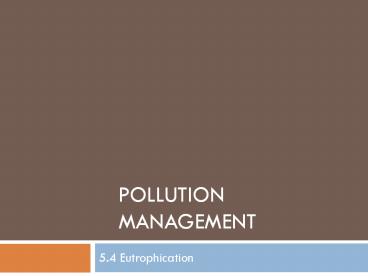Pollution Management - PowerPoint PPT Presentation
Title:
Pollution Management
Description:
POLLUTION MANAGEMENT 5.4 Eutrophication Assessment Statements 5.4.1 Outline the processes of eutrophication. 5.4.2 Evaluate the impacts of eutrophication. 5.4.3 ... – PowerPoint PPT presentation
Number of Views:75
Avg rating:3.0/5.0
Title: Pollution Management
1
Pollution Management
- 5.4 Eutrophication
2
Assessment Statements
- 5.4.1 Outline the processes of eutrophication.
- 5.4.2 Evaluate the impacts of eutrophication.
- 5.4.3 Describe and evaluate pollution management
strategies with respect to eutrophication.
3
5.4.1 Outline the processes of eutrophication.
- Eutrophication refers to the nutrient enrichment
of streams, ponds, and groundwater. - It is caused when increased levels of nitrogen or
phosphorus are carried into water bodies. - It can cause algal blooms, oxygen starvation, and
eventually the decline of biodiversity in aquatic
ecosystems. - Phosphorus in the form of phosphates often come
from domestic detergents
4
5.4.1 Outline the processes of eutrophication.
- Nitrogen often comes from burning of fossil fuels
or from fertilizers applied to soil - Eutrophication involves
- Increase in nitrates and phosphates in water
- Rapid growth of algae
- Light blocked from submerged aquatic plants
- Accumulation of dead organic matter
- Increased activity of decomposers
- Increased removal of oxygen by decomposers
- Reduced oxygen kills fish and other organisms
5
5.4.2 Evaluate the impacts of eutrophication.
- Main reasons high concentrations of nitrogen in
rivers and groundwater are a problem - Nitrogen compounds can cause undesirable effects
in the aquatic ecosystems, especially excessive
growth of algae. - Loss of fertilizer is an economic loss to the
farmer. - High concentrations of nitrates in drinking water
may increase stomach cancer and blue baby
syndrome (due to insufficient oxygen in the
mothers blood for the developing baby) rates.
6
5.4.3 Describe and evaluate pollution managements
strategies with respect to eutrophication.
- Main ways of dealing with eutrophication
Altering human activities, regulating and
reducing the nutrient source, clean up
strategies. - Altering the human activities that produce
pollution by using alternative types of
fertilizer, detergent, etc. - Avoid using nitrogen fertilizers between
mid-September and mid-February. - Use autumn-sown crops.
- Sow autumn-sown crops as early as possible and
maintain crop cover thru autumn and winter.
7
5.4.3 Describe and evaluate pollution management
strategies with respect to eutrophication.
- Use split applications to obtain the best match
of nitrogen supply and demand and reduce risk of
nitrogen loss cereals March, Grass monthly - Do not apply nitrogen next to headlands.
- Use less nitrogen if previous year was dry.
- Do not plow up grass.
- Use steep slopes for pasture, and flat lands for
crops. - Incorporate straw into the soil
- Direct drilling and minimal cultivation reduce
nitrogen loss by up to half.
8
5.4.3 Describe and evaluate pollution management
strategies with respect to eutrophication.
- Regulating and reducing pollutants at sewage
treatment plants - Perform phosphate stripping (caused to
precipitate out) on sewage treatment - Use zero/low-phosphorus detergents
- Full loads in washing machines
- Wash vehicles on porous surfaces away from drains
or gutters - Use less fertilizers on gardens
- Compost garden and food waste
- Collect and bury pet feces
9
5.4.3 Describe and evaluate pollution management
strategies with respect to eutrophication.
- Clean up and restoration of polluted water by
pumping mud from eutrophic lakes - Precipitation (Treatment to precipitate
phosphates) - Removal of nutrient-enriched sediments like mud
pumping - Removal of biomass and using it for thatching or
fuel - Prevention is better than treating as it is far
more technically feasible, cheaper, and provides
better products































